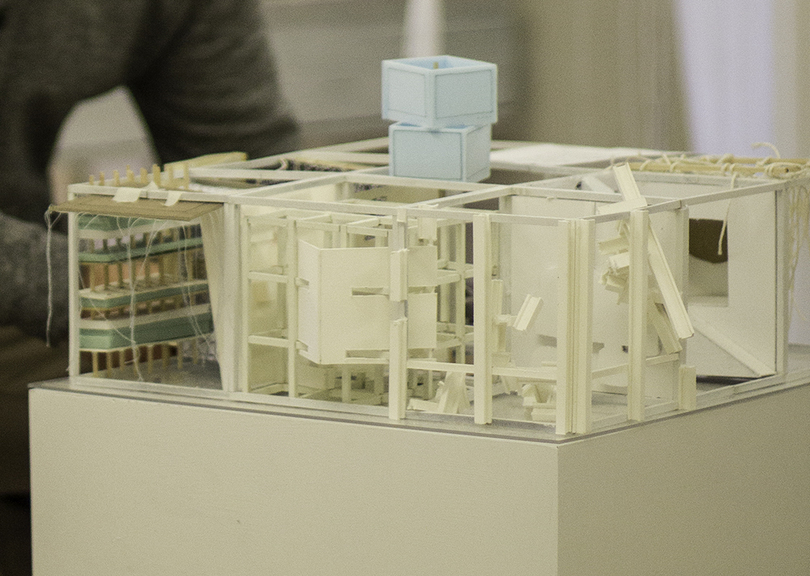Welcome to the Parti: Architecture professor bridges function, aesthetics in exhibit
Jonathan Louie stands, hands on his hips, examining his latest architectural installation.
The structure in front of him is a mixture of polished mirrors, hanging yarn and whitewashed wooden planks. A projector casts shadows across a thin sheet while a polka-dotted canvas hangs beneath a trio of plasma screen TVs. There’s even a wine glass or two.
This is Parti Wall, a student-created installation Louie produced and managed. It’s a 4-foot-high grid consisting of nine rooms, each representative of a different mentor at the Syracuse University’s School of Architecture. It took three days to complete, and as of April 8, is now sprawled in its entirety across the atrium of Slocum Hall, eclectic draperies and all.
“The students and mentors who made these rooms, they had to also consider the adjacent sections,” Louie said. “I wanted to show this collaboration, this event, between mentors with varying artistic and architectural sensibilities.”
Louie, an assistant professor at SOA, said that many architects think a tension is developing in their field –– a split between those who focus on form and function, and those who are more concerned with aesthetics and beauty.
If such a barrier does exist, Louie has spent the better part of his career actively demolishing it with nothing but a drafting table and a multitude of worn-down pencils.
When he’s not educating SOA students on the intersection between art and architecture, he can be found by Los Angeles pool sides and Palm Springs putting greens, where he just finished curating “On the Road,” a California-based traveling exhibit that meshes architectural practice with artistic form.
“These installations, if they’re sitting in a white gallery, they lose their charge,” Louie said. “I’ve always been interested in finding new ways to convey ideas, and how you can use an event like this as a protagonist for your work.”
Louie has carried this mentality all the way from his youth to his professional career, shaping his ideas throughout extensive travels.
Louie was born in Hawaii. He pronounces the state’s name differently, placing a hard islander emphasis on the last syllable before reverting back to his mainland accent. Growing up in Honolulu instilled in Louie a sense of leisure and beauty, he said, planting the seeds that would grow into his artistic aims within the architectural field.
As he strides between the partitions of Parti Wall, he reflects on the installation as a summary of his field as a whole; all of these different mentalities coming together to coalesce when they could have violently clashed.
“Architecture, really, is just an accumulation of tons of different ideas,” Louie said. “I’ve been fortunate enough to have many inspiring mentors throughout my life and career. You could say that everything I do now is, in part, their work –– a collection of their ideas.”
Upon graduation from Syracuse University as an undergrad in 2007, Louie pursued further studies on his own whims. His wanderlust eventually led him to Holland, where he continued to explore architecture.
“I did some work in New York, I did some in Boston,” he said. “I moved out to Seattle. I’ve been everywhere.”
Bess Krietemeyer, also an assistant professor at SOA, is exploring ideas similar to Louie’s. She said that architects are assuming this new role of a bridge between function and aesthetics.
The struggle to balance function and aesthetics is synonymous with architecture itself, she said, and the solution to the problem lies in exploring new ways to express ideas.
“I really think that technology and beauty can coexist,” she said. “You don’t have to place yourself in one camp or another. It’s a matter of placing yourself in the middle.”
Louie has been comfortably seated there for a while now.
Alan Smart, a fellow assistant professor of Louie’s, is there beside Louie. Smart said that much of the future of urban planning depends on architects changing their approaches.
“You have these people, myself included, who don’t look at the problem as being, ‘What is architecture?’” Smart said. “Instead, we try to ask, ‘What is architecture for, and what is it capable of?’”
Louie remembers the road trip he took last year to get to Syracuse following the SOA’s job offer. He stopped in Utah to see “Spiral Jetty,” an earthwork of mud and clay by Robert Smithson, a renowned land artist.
The jetty extends into Great Salt Lake, and as he walked on the black basalt rocks, Louie remembered thinking that he felt like a giant walking on stars, like the jetty was his own personal solar system.
“I think we should be having fun with architectural discipline,” he said. “I’m always going to have to think about scale, location, time and cost. But it can become so interesting if you just stand back and get out of your own way.”
As he takes a final step back to see the expressive Parti Wall from the outside, Louie’s smile widens, as if wondering when he’ll complete his own Spiral Jetty, complete with stars for the next generation of giants to walk on.
Published on April 22, 2014 at 1:00 am







